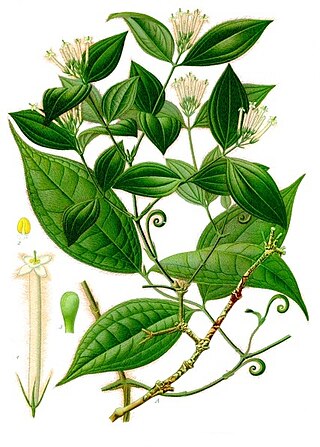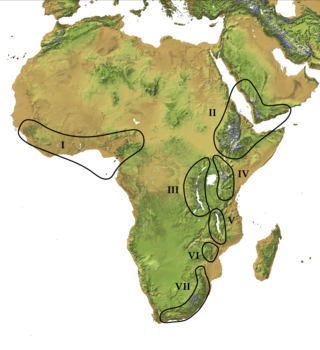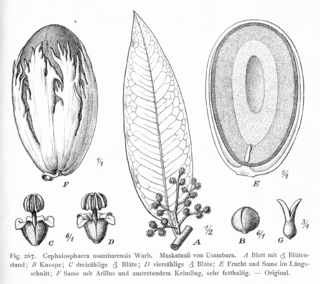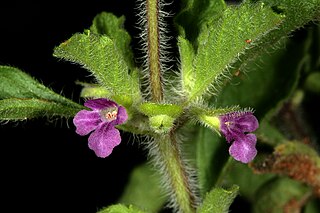
Strychnos is a genus of flowering plants, belonging to the family Loganiaceae. The genus includes about 100 accepted species of trees and lianas, and more than 200 that are as yet unresolved. The genus is widely distributed around the world's tropics and is noted for the presence of poisonous indole alkaloids in the roots, stems and leaves of various species. Among these alkaloids are the well-known and virulent poisons strychnine and curare.

Mammea is a flowering plant genus with about 70 species in the family Calophyllaceae. Its members are evergreen trees having edible fruits. The flowers are polygamous, with a unitary calyx opening into two or three valvate sepals. There are 4 to 8 petals. Berries are formed, containing 1 to 4 seeds. The leaves are rigid, coriaceous and often have pellucid dots.

Ocotea is a genus of flowering plants belonging to the family Lauraceae. Many are evergreen trees with lauroid leaves.
Thecacoris is a genus of flowering plant belonging to the family Phyllanthaceae first described as a genus in 1821. It is native to tropical Africa and Madagascar. It is dioecious, with male and female flowers on separate plants, although it may rarely be monoecious.
Kuloa usambarensis is a species of tree in the laurel family (Lauraceae). It is native to eastern Africa in Kenya, Tanga Region of Tanzania, and locally in Uganda, where it occurs at 1600–2600 m elevation in high rainfall Afromontane cloud forest. Common names include East African camphorwood, mkulo (Tanzania), mwiha (Uganda), muwong, muzaiti, and maasi.

The Afromontane regions are subregions of the Afrotropical realm, one of the Earth's eight biogeographic realms, covering the plant and animal species found in the mountains of Africa and the southern Arabian Peninsula. The Afromontane regions of Africa are discontinuous, separated from each other by lower-lying areas, and are sometimes referred to as the Afromontane archipelago, as their distribution is analogous to a series of sky islands.

Lasiodiscus, commonly known as red-hair bushes, is a small plant genus in the family Rhamnaceae. It is endemic to Africa and its adjacent islands.
Mikaniopsis is a genus of African flowering plant in the groundsel tribe within the sunflower family.

Brochoneura usambarensis is a species of tree native to the moist evergreen forests of Kenya and Tanzania. It is the sole species in genus Brochoneura.
Neohemsleya is a genus of plant in family Sapotaceae described as a genus in 1991.

Antiaris toxicaria is a tree in the mulberry and fig family, Moraceae. It is the only species currently recognized in the genus Antiaris. The genus Antiaris was at one time considered to consist of several species, but is now regarded as just one variable species which can be further divided into five subspecies. One significant difference within the species is that the size of the fruit decreases as one travels from Africa to Polynesia. Antiaris has a remarkably wide distribution in tropical regions, occurring in Australia, tropical Asia, tropical Africa, Indonesia, the Philippines, Tonga, and various other tropical islands. Its seeds are spread by various birds and bats, and it is not clear how many of the populations are essentially invasive. The species is of interest as a source of wood, bark cloth, and pharmacological or toxic substances.

Cymothoe caenis, the common glider, is a species of butterfly of the family Nymphalidae. It is found in Guinea, Sierra Leone, Liberia, Ivory Coast, Ghana, Togo, southern Nigeria, Cameroon, the Republic of the Congo, the Central African Republic, Angola, the Democratic Republic of the Congo, Uganda, Tanzania and Zambia. The habitat consists of forests and heavy woodland. It is a migratory species.

The East African montane forests is a montane tropical moist forest ecoregion of eastern Africa. The ecoregion comprises several separate areas above 2000 meters in the mountains of South Sudan, Uganda, Kenya, and Tanzania.

Northern Zanzibar–Inhambane coastal forest mosaic, also known as the Northern Swahili coastal forests and woodlands, is a tropical moist broadleaf forest ecoregion of coastal East Africa. The ecoregion includes a variety of habitats, including forest, savanna and swamps.

Strychnos usambarensis is a shrub or small tree up to 15m tall or a 70m long liane of Sub-Saharan Africa, occurring in forest and woodland, mountain ravines and coastal bush, often on rocky slopes and named for the Usambara Mountains of Tanzania. The species is found from Guinea east to Nigeria, from Congo east to Kenya and south to kloofs of the Magaliesberg of South Africa. Bantu tribes from Rwanda and Tanzania produce an arrow poison from the root bark and leaves of this species, sometimes combining it with extracts from other plants.

Vachellia robusta, the splendid thorn, is an Afrotropical tree species.

Endostemon (keepsafe) is a genus of plants in the family Lamiaceae, first described in 1910. It is native primarily to eastern Africa, with some species in central and southern Africa, the Arabian Peninsula, Madagascar, and the Indian subcontinent.
- Endostemon albusA.J.Paton, Harley & M.M.Harley - Kenya, Tanzania, Mozambique
- Endostemon camporum(Gürke) M.R.Ashby - Kenya, Tanzania
- Endostemon ctenoneurusHarley - Kenya, Somalia
- Endostemon glandulosusHarley & Sebsebe - Ethiopia
- Endostemon gracilis(Benth.) M.R.Ashby - Kenya, Somalia, Tanzania, Yemen
- Endostemon kelleri(Briq.) Ryding ex A.J.Paton & Harley - Kenya, Somalia, Ethiopia
- Endostemon leucosphaerus(Briq.) A.J.Paton, Harley & M.M.Harley - Somalia, Ethiopia
- Endostemon membranaceus(Benth.) Ayob. ex A.J.Paton & Harley - Cameroon, Angola, Central African Republic
- Endostemon obbiadensis(Chiov.) M.R.Ashby - Somalia
- Endostemon obtusifolius(E.Mey.) N.E.Br. - from South Africa north to Angola and Tanzania
- Endostemon racemosusRyding, A.J.Paton & Thulin - Somalia
- Endostemon stenocaulis(Hedge) Ryding, A.J.Paton & Thulin - Somalia
- Endostemon tenuiflorus(Benth.) M.R.Ashby - eastern + southern Africa, Madagascar, Arabian Peninsula
- Endostemon tereticaulis(Poir.) M.R.Ashby - widespread across much of tropical Africa, also Yemen + Saudi Arabia
- Endostemon tomentosusHarley & Sebsebe - Somalia
- Endostemon tubulascens(Briq.) M.R.Ashby - Angola
- Endostemon usambarensisM.R.Ashby - Tanzania
- Endostemon villosus(Briq.) M.R.Ashby - central Africa
- Endostemon viscosus(Roth) M.R.Ashby - India, Assam, Sri Lanka
- Endostemon wakefieldii(Baker) M.R.Ashby - Kenya
Iodes is a genus of flowering plants belonging to the family Icacinaceae.
Kuloa is a genus of plants in the laurel family (Lauraceae). It contains three species native to central Africa, which were previously classed in genus Ocotea.












